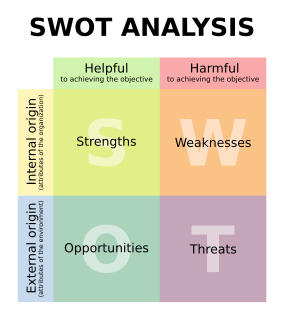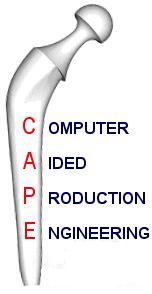Related Research Articles
Project management is the practice of leading the work of a team to achieve goals and meet success criteria at a specified time. The primary challenge of project management is to achieve all of the project goals within the given constraints. This information is usually described in project documentation, created at the beginning of the development process. The primary constraints are scope, time, quality and budget. The secondary challenge is to optimize the allocation of necessary inputs and apply them to meet pre-defined objectives.

Risk management is the identification, evaluation, and prioritization of risks followed by coordinated and economical application of resources to minimize, monitor, and control the probability or impact of unfortunate events or to maximize the realization of opportunities.
In business theory, a disruptive innovation is an innovation that creates a new market and value network and eventually disrupts an existing market and value network, displacing established market-leading firms, products, and alliances. The term was defined and first analyzed by the American scholar Clayton M. Christensen and his collaborators beginning in 1995, and has been called the most influential business idea of the early 21st century.

Iterative and incremental development is any combination of both iterative design or iterative method and incremental build model for development.
In business and engineering, new product development (NPD) covers the complete process of bringing a new product to market. A central aspect of NPD is product design, along with various business considerations. New product development is described broadly as the transformation of a market opportunity into a product available for sale. The product can be tangible or intangible, though sometimes services and other processes are distinguished from "products." NPD requires an understanding of customer needs and wants, the competitive environment, and the nature of the market. Cost, time and quality are the main variables that drive customer needs. Aiming at these three variables, innovative companies develop continuous practices and strategies to better satisfy customer requirements and to increase their own market share by a regular development of new products. There are many uncertainties and challenges which companies must face throughout the process. The use of best practices and the elimination of barriers to communication are the main concerns for the management of the NPD.
Benchmarking is the practice of comparing business processes and performance metrics to industry bests and best practices from other companies. Dimensions typically measured are quality, time and cost.
Product management is an organisational function within a company dealing with new product development, business justification, planning, verification, forecasting, pricing, product launch, and marketing of a product or products at all stages of the product lifecycle. Similarly, product lifecycle management (PLM) integrates people, data, processes and business systems. It provides product information for companies and their extended supply chain enterprise.
Software development is the process of conceiving, specifying, designing, programming, documenting, testing, and bug fixing involved in creating and maintaining applications, frameworks, or other software components. Software development is a process of writing and maintaining the source code, but in a broader sense, it includes all that is involved between the conception of the desired software through to the final manifestation of the software, sometimes in a planned and structured process. Therefore, software development may include research, new development, prototyping, modification, reuse, re-engineering, maintenance, or any other activities that result in software products.

SWOT analysis is a strategic planning technique used to help a person or organization identify strengths, weaknesses, opportunities, and threats related to business competition or project planning. It is designed for use in the preliminary stages of decision-making processes and can be used as a tool for evaluation of the strategic position of a city or organization. It is intended to specify the objectives of the business venture or project and identify the internal and external factors that are favorable and unfavorable to achieving those objectives. Users of a SWOT analysis often ask and answer questions to generate meaningful information for each category to make the tool useful and identify their competitive advantage. SWOT has been described as the tried-and-true tool of strategic analysis, but has also been criticized for its limitations.
Productivity describes various measures of the efficiency of production. Often, a productivity measure is expressed as the ratio of an aggregate output to a single input or an aggregate input used in a production process, i.e. output per unit of input, typically over a specific period of time. Most common example is the (aggregate) labour productivity measure, e.g., such as GDP per worker. There are many different definitions of productivity and the choice among them depends on the purpose of the productivity measurement and/or data availability. The key source of difference between various productivity measures is also usually related to how the outputs and the inputs are aggregated into scalars to obtain such a ratio-type measure of productivity.

In systems engineering, information systems and software engineering, the systems development life cycle (SDLC), also referred to as the application development life-cycle, is a process for planning, creating, testing, and deploying an information system. The systems development life cycle concept applies to a range of hardware and software configurations, as a system can be composed of hardware only, software only, or a combination of both. There are usually six stages in this cycle: requirement analysis, design, development and testing, implementation, documentation, and evaluation.

In industry, product lifecycle management (PLM) is the process of managing the entire lifecycle of a product from inception, through engineering design and manufacture, to service and disposal of manufactured products. PLM integrates people, data, processes and business systems and provides a product information backbone for companies and their extended enterprise.
In commerce, time to market (TTM) is the length of time it takes from a product being conceived until its being available for sale. TTM is important in industries where products are outmoded quickly. A common assumption is that TTM matters most for first-of-a-kind products, but actually the leader often has the luxury of time, while the clock is clearly running for the followers.

Operations management is an area of management concerned with designing and controlling the process of production and redesigning business operations in the production of goods or services. It involves the responsibility of ensuring that business operations are efficient in terms of using as few resources as needed and effective in terms of meeting customer requirements. Operations management is primarily concerned with planning, organizing and supervising in the contexts of production, manufacturing or the provision of services.

Computer-aided production engineering (CAPE) is a relatively new and significant branch of engineering. Global manufacturing has changed the environment in which goods are produced. Meanwhile, the rapid development of electronics and communication technologies has required design and manufacturing to keep pace.
The following outline is provided as an overview of and topical guide to management:
Production is a process of combining various material inputs and immaterial inputs in order to make something for consumption (output). It is the act of creating an output, a good or service which has value and contributes to the utility of individuals. The area of economics that focuses on production is referred to as production theory, which in many respects is similar to the consumption theory in economics.
A glossary of terms relating to project management and consulting.
Lean product development (LPD) is a lean approach to counter the challenges of product development, notably:
The following outline is provided as an overview of and topical guide to project management:
References
- ↑ Wheelwright, Steven; Clark, Kim B. (1992). Revolutionizing product development. Simon and Schuster. p. 48. ISBN 0-02-905515-6.
- ↑ Rebecca Henderson. "Actually Doing (Technology & Product) Strategy" . Retrieved 2009-04-28.
- ↑ Henry C. Co. "Technology in Strategic Planning". Archived from the original on 2010-12-17. Retrieved 2009-04-28.
- ↑ Dr. Savas Ozatalay. "Project Management". Archived from the original on 2006-09-01. Retrieved 2009-04-28.
- ↑ Verzuh, Eric (2003). The portable MBA in project management . John Wiley and Sons. p. 87. ISBN 0-471-26899-2.
- ↑ Wheelwright, Steven; Kim B. Clark (1992). Revolutionizing product development. Simon and Schuster. p. 50. ISBN 0-02-905515-6.